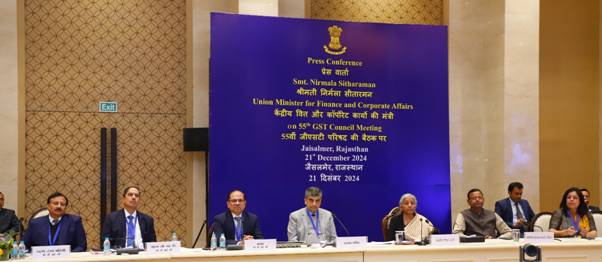As of May 2024, India’s gross Goods and Services Tax (GST) revenue collection stands at an impressive ₹1.73 lakh crore, marking a 10% year-on-year growth. This robust increase is largely attributed to a significant rise in domestic transactions and a slight decline in imports. Here’s a comprehensive look at the details and implications of these collections.
Gross GST Revenue Collection for May 2024
- Total Collection: ₹1.73 lakh crore
- Year-on-Year Growth: 10%
- Domestic Transaction Growth: 15.3%
- Import Decline: 4.3%
- Net GST Revenue (after refunds): ₹1.44 lakh crore (6.9% growth year-on-year)
Breakdown of May 2024 Collections:
- Central Goods and Services Tax (CGST): ₹32,409 crore
- State Goods and Services Tax (SGST): ₹40,265 crore
- Integrated Goods and Services Tax (IGST): ₹87,781 crore (including ₹39,879 crore from imported goods)
- Cess: ₹12,284 crore (including ₹1,076 crore from imported goods)
Cumulative GST Collections for FY 2024-25 (Till May 2024)
The gross GST revenue collection for FY 2024-25, up to May 2024, reached ₹3.83 lakh crore, demonstrating an 11.3% year-on-year growth. This includes a significant boost in domestic transactions and a marginal increase in imports.
- Total Collection: ₹3.83 lakh crore
- Year-on-Year Growth: 11.3%
- Domestic Transaction Growth: 14.2%
- Import Growth: 1.4%
- Net GST Revenue (after refunds): ₹3.36 lakh crore (11.6% growth year-on-year)
Breakdown of FY 2024-25 Collections (Till May 2024):
- Central Goods and Services Tax (CGST): ₹76,255 crore
- State Goods and Services Tax (SGST): ₹93,804 crore
- Integrated Goods and Services Tax (IGST): ₹1,87,404 crore (including ₹77,706 crore from imported goods)
- Cess: ₹25,544 crore (including ₹2,084 crore from imported goods)
Inter-Governmental Settlement
In May 2024, the central government settled ₹38,519 crore to CGST and ₹32,733 crore to SGST from the net IGST collected of ₹67,204 crore. This settlement translates to a total revenue of ₹70,928 crore for CGST and ₹72,999 crore for SGST in May 2024 after regular settlement.
For FY 2024-25 up to May 2024, the central government settled ₹88,827 crore to CGST and ₹74,333 crore to SGST from the net IGST collected of ₹154,671 crore. This results in a total revenue of ₹1,65,081 crore for CGST and ₹1,68,137 crore for SGST for the period.
Trends and State-wise Collections
The trends in monthly gross GST revenues indicate a positive growth trajectory in the current fiscal year. Below are state-wise figures of GST collected in each state during May 2024 compared to May 2023, reflecting varied growth rates across the country.
Table 1: State-wise Growth of GST Revenues during May 2024
| State/UT | May-23 | May-24 | Growth (%) |
|---|---|---|---|
| Jammu and Kashmir | 422 | 525 | 24% |
| Himachal Pradesh | 828 | 838 | 1% |
| Punjab | 1,744 | 2,190 | 26% |
| Chandigarh | 259 | 237 | -9% |
| Uttarakhand | 1,431 | 1,837 | 28% |
| Haryana | 7,250 | 9,289 | 28% |
| Delhi | 5,147 | 7,512 | 46% |
| Rajasthan | 3,924 | 4,414 | 13% |
| Uttar Pradesh | 7,468 | 9,091 | 22% |
| Bihar | 1,366 | 1,521 | 11% |
| Sikkim | 334 | 312 | -7% |
| Arunachal Pradesh | 120 | 98 | -18% |
| Nagaland | 52 | 45 | -14% |
| Manipur | 39 | 58 | 48% |
| Mizoram | 38 | 39 | 3% |
| Tripura | 75 | 73 | -3% |
| Meghalaya | 214 | 172 | -20% |
| Assam | 1,217 | 1,228 | 1% |
| West Bengal | 5,162 | 5,377 | 4% |
| Jharkhand | 2,584 | 2,700 | 4% |
| Odisha | 4,398 | 5,027 | 14% |
| Chhattisgarh | 2,525 | 2,853 | 13% |
| Madhya Pradesh | 3,381 | 3,402 | 1% |
| Gujarat | 9,800 | 11,325 | 16% |
| Dadra and Nagar Haveli and Daman & Diu | 324 | 375 | 16% |
| Maharashtra | 23,536 | 26,854 | 14% |
| Karnataka | 10,317 | 11,889 | 15% |
| Goa | 523 | 519 | -1% |
| Lakshadweep | 2 | 1 | -39% |
| Kerala | 2,297 | 2,594 | 13% |
| Tamil Nadu | 8,953 | 9,768 | 9% |
| Puducherry | 202 | 239 | 18% |
| Andaman and Nicobar Islands | 31 | 37 | 18% |
| Telangana | 4,507 | 4,986 | 11% |
| Andhra Pradesh | 3,373 | 3,890 | 15% |
| Ladakh | 26 | 15 | -41% |
| Other Territory | 201 | 207 | 3% |
| Center Jurisdiction | 187 | 245 | 30% |
| Grand Total | 1,14,261 | 1,31,783 | 15% |
Table 2: SGST & SGST Portion of IGST Settled to States/UTs in May 2024 (₹ in crore)
| State/UT | Pre-Settlement SGST May-23 | Pre-Settlement SGST May-24 | Growth (%) | Post-Settlement SGST May-23 | Post-Settlement SGST May-24 | Growth (%) |
|---|---|---|---|---|---|---|
| Jammu and Kashmir | 178 | 225 | 26% | 561 | 659 | 17% |
| Himachal Pradesh | 189 | 187 | -1% | 435 | 436 | 0% |
| Punjab | 638 | 724 | 14% | 1,604 | 1,740 | 8% |
| Chandigarh | 48 | 54 | 12% | 168 | 178 | 6% |
| Uttarakhand | 411 | 476 | 16% | 666 | 714 | 7% |
| Haryana | 1,544 | 1,950 | 26% | 2,568 | 3,025 | 18% |
| Delhi | 1,295 | 1,477 | 14% | 2,539 | 2,630 | 4% |
| Rajasthan | 1,386 | 1,506 | 9% | 3,020 | 3,315 | 10% |
| Uttar Pradesh | 2,384 | 2,736 | 15% | 5,687 | 6,848 | 20% |
| Bihar | 623 | 695 | 11% | 2,058 | 2,298 | 12% |
| Sikkim | 31 | 26 | -15% | 84 | 66 | -21% |
| Arunachal |
Why GST Revenue is Increasing Every Month
The steady increase in GST revenue collections month-over-month can be attributed to several key factors that reflect the strengthening of the Indian economy and improvements in the tax administration system. Here’s an in-depth look at the reasons behind this upward trend:
1. Economic Growth
- Recovery Post-Pandemic: As the economy recovers from the impacts of the COVID-19 pandemic, there is a notable increase in business activities. This recovery is driving higher consumption and production, which in turn boosts GST collections.
- Increase in Consumer Spending: With rising disposable incomes and a growing middle class, consumer spending on goods and services has increased, leading to higher GST revenues.
2. Improved Compliance and Enforcement
- E-Invoicing and Digital Initiatives: The introduction of e-invoicing and other digital measures has streamlined the tax filing process, making it easier for businesses to comply with GST regulations. This has reduced evasion and increased the accuracy of tax reporting.
- Stringent Enforcement: The government’s efforts to crack down on tax evasion and fraud through audits, data analytics, and stricter penalties have improved compliance rates among taxpayers.
3. Expanding Tax Base
- Inclusion of More Taxpayers: The government has been successful in bringing more businesses under the GST regime through targeted outreach and awareness programs. This expanded tax base contributes to higher overall collections.
- Formalization of the Economy: As more informal sector businesses become formalized, they start contributing to GST revenues. This shift is partly driven by incentives and support provided to small and medium enterprises (SMEs) to formalize their operations.
4. Seasonal and Cyclical Factors
- Festive and Holiday Seasons: Certain months experience spikes in consumption due to festivals, holidays, and sales events. These periods typically see higher GST collections due to increased sales of goods and services.
- End of Financial Year: Businesses tend to clear their inventories and settle accounts towards the end of the financial year, resulting in higher transactions and, consequently, higher GST revenues.
5. Policy Reforms and Rate Rationalization
- Adjustments in GST Rates: Periodic rationalization of GST rates to make them more industry-friendly can lead to higher compliance and greater collection. For example, reducing rates on essential items can encourage voluntary compliance.
- Simplification of Procedures: Simplified GST filing procedures and reduced compliance burden for small businesses have made it easier for businesses to file returns and pay taxes on time.
6. Increased Surveillance and Technology Use
- Data Analytics and AI: The use of data analytics and artificial intelligence by the GST authorities helps in identifying discrepancies and ensuring better compliance. This proactive approach helps in plugging revenue leakages.
- GST Network (GSTN) Improvements: Continuous enhancements to the GSTN infrastructure have improved the efficiency of the GST system, making it more robust and user-friendly.
7. Rising Import Duties
- Higher Duties on Imports: An increase in duties on certain imported goods can lead to higher IGST (Integrated GST) collections at the point of entry, contributing to the overall increase in GST revenue.
Conclusion
The consistent increase in GST revenue collections is a positive sign of economic recovery, improved tax compliance, and effective administrative measures. By addressing both systemic issues and leveraging technology, the government has managed to create a more efficient and comprehensive GST framework. This trend is likely to continue as the economy grows and further refinements are made to the tax system.
Visit www.cagurujiclasses.com for practical courses











